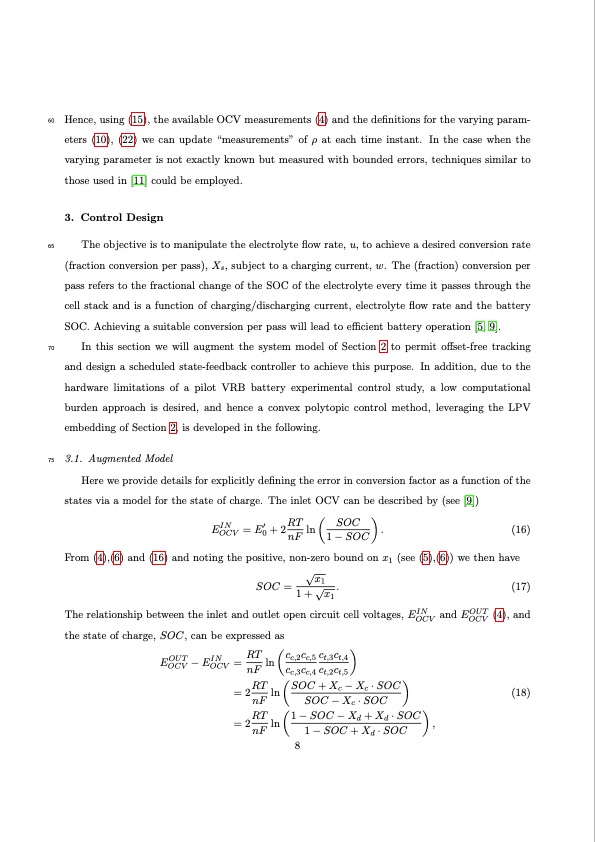
PDF Publication Title:
Text from PDF Page: 008
60 65 70 75 Hence, using (15), the available OCV measurements (4) and the definitions for the varying param- eters (10), (22) we can update “measurements” of ρ at each time instant. In the case when the varying parameter is not exactly known but measured with bounded errors, techniques similar to those used in [11] could be employed. 3. Control Design The objective is to manipulate the electrolyte flow rate, u, to achieve a desired conversion rate (fraction conversion per pass), Xs, subject to a charging current, w. The (fraction) conversion per pass refers to the fractional change of the SOC of the electrolyte every time it passes through the cell stack and is a function of charging/discharging current, electrolyte flow rate and the battery SOC. Achieving a suitable conversion per pass will lead to efficient battery operation [5, 9]. In this section we will augment the system model of Section 2 to permit offset-free tracking and design a scheduled state-feedback controller to achieve this purpose. In addition, due to the hardware limitations of a pilot VRB battery experimental control study, a low computational burden approach is desired, and hence a convex polytopic control method, leveraging the LPV embedding of Section 2, is developed in the following. 3.1. Augmented Model Here we provide details for explicitly defining the error in conversion factor as a function of the states via a model for the state of charge. The inlet OCV can be described by (see [9]) IN ′ RTSOC EOCV=E0+2nFln 1−SOC . (16) From (4),(6) and (16) and noting the positive, non-zero bound on x1 (see (5),(6)) we then have √x1 SOC = 1 + √x . 1 The relationship between the inlet and outlet open circuit cell voltages, EIN OCV (17) and EOUT (4), and OCV (18) the state of charge, SOC, can be expressed as OUT IN RT cc,2cc,5 ct,3ct,4 EOCV − EOCV = nF ln cc,3cc,4 ct,2ct,5 RT = 2 nF ln RT = 2 nF ln SOC+Xc −Xc ·SOC SOC − Xc · SOC 1−SOC−Xd +Xd ·SOC , 8 1 − SOC + Xd · SOCPDF Image | Electrolyte Flow Rate Control Vanadium Redox Flow Batteries

PDF Search Title:
Electrolyte Flow Rate Control Vanadium Redox Flow BatteriesOriginal File Name Searched:
2201-12812.pdfDIY PDF Search: Google It | Yahoo | Bing
Salgenx Redox Flow Battery Technology: Salt water flow battery technology with low cost and great energy density that can be used for power storage and thermal storage. Let us de-risk your production using our license. Our aqueous flow battery is less cost than Tesla Megapack and available faster. Redox flow battery. No membrane needed like with Vanadium, or Bromine. Salgenx flow battery
| CONTACT TEL: 608-238-6001 Email: greg@salgenx.com | RSS | AMP |